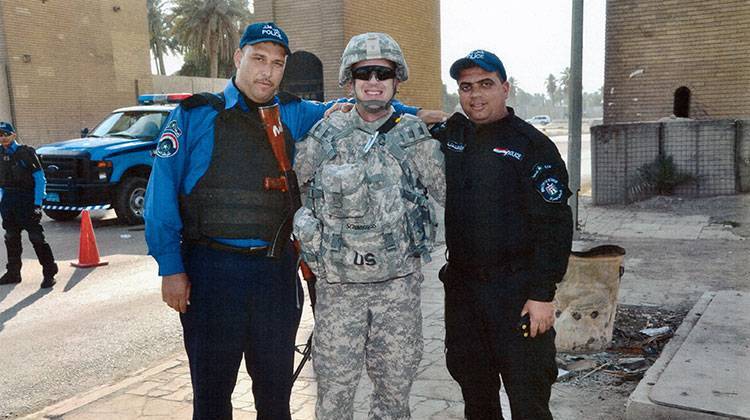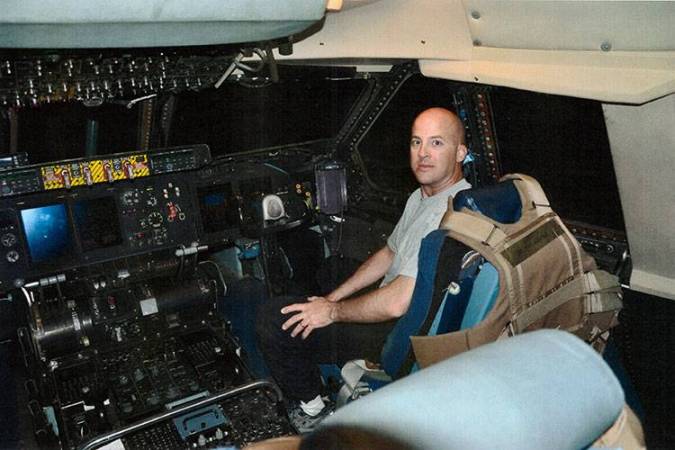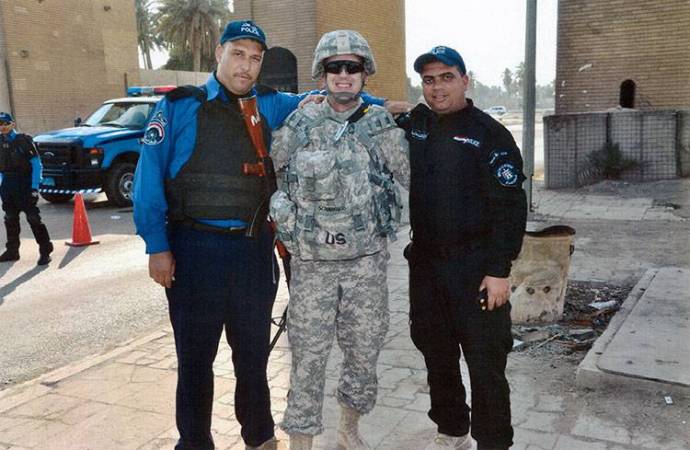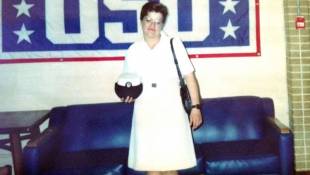
Andrew Schnieders, shown here while serving in Iraq with the National Guard, credits his art therapy with helping him begin to heal emotionally after returning home from war.
Photo courtesy Andrew SchniedersA few years after the terrorist attacks of Sept. 11, 2001 Andrew Schnieders, a high school music teacher in Avon, decided to join the Indiana National Guard.
“Here I was, 34 years old, semi accomplished, family in the making, you know, had a 5 year-old and a 3 year-old and things are going well, but we’re in this war," Schnieders said.
In 2009, Schneiders, with the Army branch of the Guard, was sent on a 13-month deployment to Balad, Iraq with the 38th Combat Aviation Brigade. The stress of combat and the constant grind of 12 and 14 hour days – including a 10-month stretch without a single day off – took a toll.
“You’re getting shot at and you’re getting mortared. We got mortared all the time. That becomes the norm. We made a joke about it," Schnieders said. "When you first get there and they yell incoming over the system or whatever and the C-ram’s going off you’re running for the bunker. Two months in, you walk to the bunker. Three months in, five months in, you’re just taking a shower through it and if you get popped you get popped, whatever. You get this complacency and this numbing sensation sometimes of what’s going on around you.”
Schneiders was about halfway through his deployment when the U.S. announced an end to combat and a more intent focus on training Iraqi forces. The less intense pace gave him more time to think – and more time to feel.
“I started noticing a change – especially in my aggression – things got dark. And at first it was just like –you know, you just accept it. You know it’s coming. It’s not a surprise – but when you can’t shake it off and then everyday gets worse and that violence comes out in you, maybe, I know a lot of people experience that and go through it," Scnieders said. "I know through therapy that I wasn’t alone in those thoughts. But at the time I had to deal with it myself because I’m all I had.”
He also had his creativity. Schneiders began putting pencil to paper, finding solace in the sketches he drew of his surroundings.
“You know, even though you’ve got a big concrete blast wall in front of you, you’re still seeing the scenery change and the colors and things and then you start noticing that. And then you start drawing what you’re seeing and filling that void and that time with the creativity part of it and allowing that to come out," he said. "You know, making objects on paper and having that realization of there’s still beauty left in the world.”
When his tour ended, Schnieders returned to a once familiar world – but now everything “normal” - like cell phones, socializing and driving in traffic - felt foreign and overwhelming.
“You either want to be normal, so you fake your way out of it. Or, you just want to hide it and try to move on with life," Schnieders said. "But if you don’t address it, it doesn’t. I mean, maybe for some people it does. But for me, there came that time where I had to start addressing the issues and facing them.”
Schnieders signed up for group art therapy at the Indianapolis VA Hospital – a pilot project spearheaded by Herron School of Art and Design associate professor and art therapist Juliet King and the VA’s Dr. Brandi Luedtke. Schnieders discovered illustrating his troubled Iraq experiences with art and then talking with his fellow vets about it was very healing.
“It might be very dark or depressive and you’re just getting it out on the paper or constructing it with you hands. In our group therapy, some guys and girls wouldn’t say a word they’re quiet the whole time. But when we would get to the end and we would share – some of the emotion that they are putting into that project was like overwhelming at times. You’re like, “Wow, they’re really going through that,” Schnieders said. "And then, how neat was it to see them express that in art – you know – being creative with it. But even more so, getting it out - getting on that healing path. That was motivating for me.”
Art therapy is much more complex than just drawing a picture. Juliet King, the director of Herron’s Art Therapy program, says art therapists are licensed mental health counselors trained to understand how different art materials, like paint and clay, help people express different emotions and traumas – things they might not even be able to verbalize. And they’re trained to understand metaphor and symbolism as it’s connected to non-verbal communication.
“What art therapy has the capacity to do is assist and support the non-verbal communication through the use of materials and media," King said, "and then through practice be able to attach words to what those feelings are and develop more of a cohesive and safe narrative to understand their experience.”
Schnieders wants to continue healing and live in the present. He credits art therapy at the VA with helping him on his journey. The teacher in him hopes by sharing his story with other service members will inspire them to reach out and find their path to healing.
This story was produced as part of the “Veterans Coming Home Project.” Learn more about the project here.
 DONATE
DONATE








 View More Articles
View More Articles


 Support WFYI. We can't do it without you.
Support WFYI. We can't do it without you.